Inequalities Chapter Notes | Mathematics Class 9 ICSE PDF Download
| Table of contents |

|
| Introduction |

|
| Theorem 3 |

|
| Theorem 4 (Converse of Theorem 3) |

|
| Theorem 5 |

|
| Corollary 1 |

|
| Corollary 2 |

|
Introduction
Inequalities are like the spice of geometry, adding a twist to how we compare lengths and angles in shapes, especially triangles and quadrilaterals. This chapter takes you on an exciting journey through the world of "greater than" and "less than," revealing secrets about sides and angles that make geometry feel like solving a puzzle. By understanding these concepts, you'll unlock the ability to compare distances and angles in a way that makes math both logical and fun!

- The symbol > means "is greater than." For example, if 'a' is larger than 'b', we write a > b.
- The symbol < means "is less than." For example, if 'a' is smaller than 'b', we write a < b.
Theorem 3
- Statement: If two sides of a triangle are unequal, the greater side has the greater angle opposite to it.
- Given: In triangle ABC, side AB is longer than side AC.
- To Prove: Angle ACB is greater than angle B.
- Construction: From side AB, cut off a segment AD equal to AC. Join points C and D.
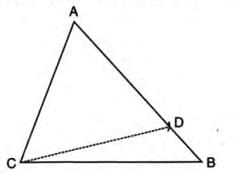
- Proof Steps:
- In triangle ACD, AC equals AD (by construction).
- Angles opposite equal sides are equal, so angle ACD equals angle ADC.
- In triangle BDC, the exterior angle ADC is greater than the interior opposite angle B.
- From the above, angle ACD is greater than angle B.
- Since angle ACD is part of angle ACB, angle ACB is greater than angle ACD, and thus angle ACB is greater than angle B.
Theorem 4 (Converse of Theorem 3)
- Statement: If two angles of a triangle are unequal, the greater angle has the greater side opposite to it.
- Given: In triangle ABC, angle CAB is greater than angle B.
- To Prove: Side BC is longer than side AC.
- Construction: Draw angle BAD equal to angle B.
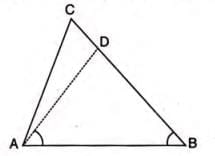
- Proof Steps:
- In triangle ABD, sides opposite equal angles (BAD and B) are equal, so AD equals BD.
- In triangle ADC, the sum of sides AD and DC is greater than side AC (triangle inequality).
- Since AD equals BD, BD plus DC (which is BC) is greater than AC.
- Thus, BC is greater than AC.
Theorem 5
- Statement: Of all lines drawn from a point outside a given straight line to that line, the perpendicular is the shortest.
- Given: Point O is outside line AB, and OP is perpendicular to AB.
- To Prove: OP is the shortest line from O to any point on AB.
- Construction: Join point O to any point Q on AB.
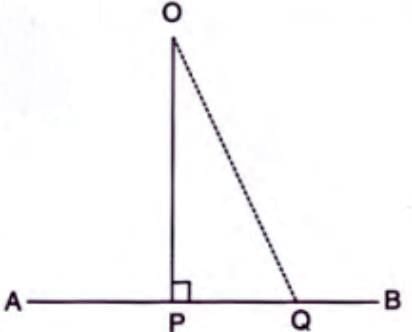
- Proof Steps:
- In right-angled triangle OPQ, angle OPQ (90°) is the greatest angle.
- The side opposite the greater angle (OQ) is greater than the side opposite the smaller angle (OP).
- Similarly, OP is shorter than any other line from O to AB.
- Thus, OP is the shortest line from O to AB.
Corollary 1
- Statement: The sum of any two sides of a triangle is always greater than the third side.
- Example:In triangle ABC:
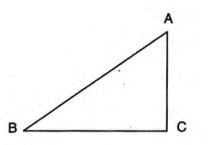
- AB + AC > BC
- AB + BC > AC
- BC + AC > AB
Corollary 2
- Statement: The difference between any two sides of a triangle is always less than the third side.
- Example:In triangle ABC, if AB is the largest side and AC is the smallest:
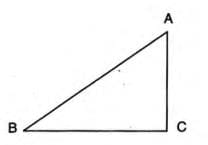
- AB - AC < BC
- AB - BC < AC
- BC - AC < AB
Example 1: In a figure, AD bisects angle A. Arrange AB, BD, and DC in descending order of their lengths.
Solution Steps: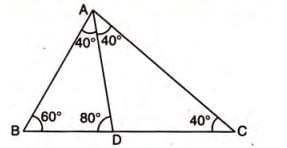
- Calculate angle BAC: 180° - (60° + 40°) = 80°.
- Since AD bisects angle A, angle BAD = angle CAD = 80°/2 = 40°.
- In triangle ABD, angle ADB = 180° - (60° + 40°) = 80°.
- In triangle ABD, side AB (opposite angle ADB, 80°) is greater than AD (opposite angle ABD, 60°), which is greater than BD (opposite angle BAD, 40°).
- In triangle ADC, sides AD and DC are equal (opposite equal angles CAD and ACD, both 40°).
- Thus, AB > DC = AD > BD.
- Answer: AB > DC > BD.
Example 2: In a figure, AC is perpendicular to line PQ, and BC = CD. Show that AE > AB.
Solution Steps: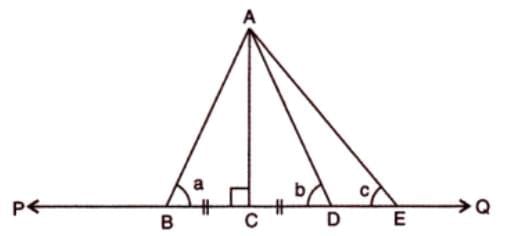
- In triangles ABC and ADC: BC = CD (given), angle ACB = angle ACD (both 90°), AC is common.
- Triangles ABC and ADC are congruent by SAS (Side-Angle-Side).
- Thus, AB = AD and angle a (at A in ABC) = angle b (at A in ADC) by CPCTC (Corresponding Parts of Congruent Triangles are Congruent).
- In triangle ADC, exterior angle b = angle c + angle DAE.
- Thus, angle b > angle c.
- Since angle a = angle b, angle a > angle c.
- In triangle ABE, angle a > angle c, so side AE (opposite angle a) is greater than side AB (opposite angle c).
- Conclusion: AE > AB.
Example 3: Problem: In a figure, AB = AC. Prove that AF > AE.
Solution:
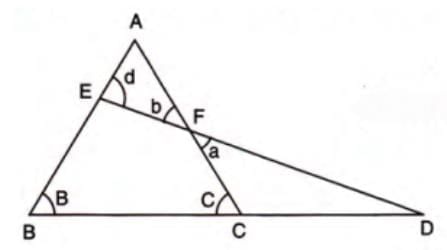
Steps:
- Since AB = AC, angles B and C are equal (angles opposite equal sides).
- In triangle FCD, exterior angle C = angle D + angle a.
- Thus, angle C > angle a.
- Since angle a = angle b (opposite equal sides FD and FE), angle C > angle b.
- In triangle EBD, exterior angle d = angle B + angle D.
- Thus, angle d > angle B, and since angle B = angle C, angle d > angle C.
- Combining, angle d > angle C > angle b, so angle d > angle b.
- In triangle AEF, angle d > angle b, so side AF (opposite angle d) is greater than side AE (opposite angle b).
- Conclusion: AF > AE.
Example 4: In a figure, AD bisects angle BAC. Prove that: (i) AB > BD, (ii) AC > CD, (iii) AB + AC > BC.
Solution:
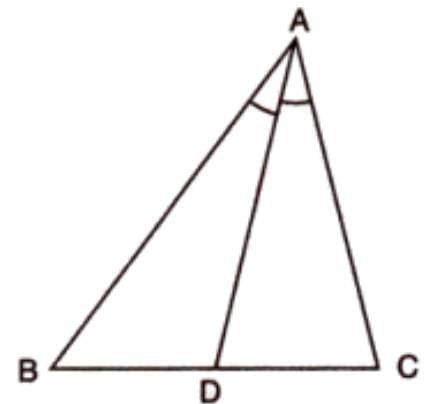
Steps:
Given: AD bisects angle BAC, so angle BAD = angle CAD.
(i) In triangle ADC, exterior angle ADB = angle CAD + angle C = angle BAD + angle C (since angle CAD = angle BAD).
- Thus, angle ADB > angle BAD.
- In triangle ABD, angle ADB > angle BAD, so side AB (opposite angle ADB) is greater than side BD (opposite angle BAD).
(ii) In triangle ABD, exterior angle ADC = angle BAD + angle B = angle CAD + angle B (since angle BAD = angle CAD).
- Thus, angle ADC > angle CAD.
- In triangle ADC, angle ADC > angle CAD, so side AC (opposite angle ADC) is greater than side CD (opposite angle CAD).
(iii) Since AB > BD and AC > CD, adding gives AB + AC > BD + CD.
- Since BD + CD = BC, AB + AC > BC.
Conclusion: (i) AB > BD, (ii) AC > CD, (iii) AB + AC > BC.
Example 5: In quadrilateral ABCD, AB is the shortest side and DC is the longest side. Prove that: (i) angle B > angle D, (ii) angle A > angle C.
Solution:
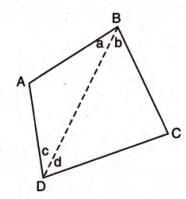
Steps:
- Join points B and D.
- In triangle ABD, side AD > AB (AB is shortest), so angle a (opposite AD) > angle c (opposite AB).
- In triangle BCD, side CD > BC (CD is longest), so angle b (opposite CD) > angle d (opposite BC).
- Adding: angle a + angle b > angle c + angle d.
- Since angle a + angle b = angle B and angle c + angle d = angle D, angle B > angle D.
- Similarly, join points A and C.
- By similar reasoning, angle A > angle C.
- Conclusion: (i) angle B > angle D, (ii) angle A > angle C.
Example 7: AD is a median of triangle ABC. Prove that AB + AC > 2 AD.
Solution:
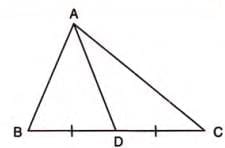
- Given: AD is a median, so BD = CD.
- Extend AD to point E such that AD = DE, so AE = 2 AD.
- Join C and E.
- In triangle ACE, AC + CE > AE (sum of two sides greater than the third).
- Since AE = 2 AD, AC + CE > 2 AD.
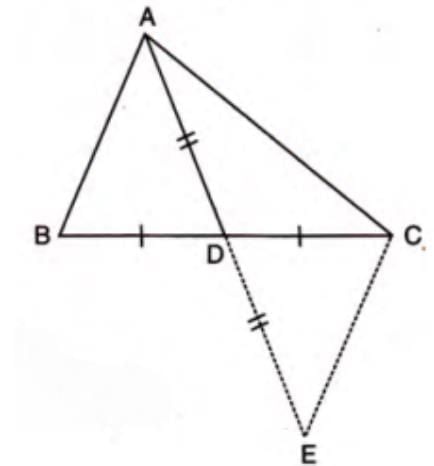
- In triangles ADB and CDE: BD = CD (given), AD = DE (by construction), angle ADB = angle CDE (vertically opposite).
- Triangles ADB and CDE are congruent by SAS.
- Thus, AB = CE by CPCTC.
- Substitute CE = AB in AC + CE > 2 AD to get AB + AC > 2 AD.
- Conclusion: AB + AC > 2 AD.
Example 6: In triangle ABC, BP is a median. Prove that PB + PA < BC + AC.
Solution:
Steps:
- Extend BP to meet AC at point M.
- In triangle BCM, BC + CM > BM (sum of two sides greater than the third).
- In triangle APM, AM + PM > AP.
- Add the inequalities: BC + CM + AM + PM > BM + AP.
- Since CM + AM = AC and BM - PM = BP, we get BC + AC > BP + AP.
- Thus, PB + PA < BC + AC.
- Conclusion: PB + PA < BC + AC.
|
28 videos|171 docs|28 tests
|
FAQs on Inequalities Chapter Notes - Mathematics Class 9 ICSE
| 1. What are inequalities in mathematics and why are they important in Class 9? |  |
| 2. What is Theorem 3 about in the context of inequalities? |  |
| 3. How does Theorem 4 serve as a converse to Theorem 3? |  |
| 4. What are the main takeaways from the corollaries related to inequalities? |  |
| 5. How can students effectively study inequalities to prepare for exams? |  |















